“And of course given how severely this virus is affecting older people and those with other health vulnerabilities, some form of shielding will almost certainly be required for the foreseeable future”
(Nicola Sturgeon on lifting “lockdown” (see here)).
In the last few weeks, as a result of the Corona Crisis, Parkswatch’s attention has shifted from the wide open spaces in our National Parks to access to farmland around settlements and greenspace in urban areas. The focus of this post is even narrower, the very right of Older People to go outdoors.
While there have been increasing numbers of people aged 80 plus taking part in Outdoor Activities (see here for 94 year old woman climbing a hill for the FIRST time), those that are able to do so are relatively few, and they are not my focus. Their rights are dependent on the draft decision making framework being by the Scottish Government acknowledging the need for Older People generally to go outdoors for their physical and mental health, respecting their right to do so and setting out a “safe” way for this to happen.
The context
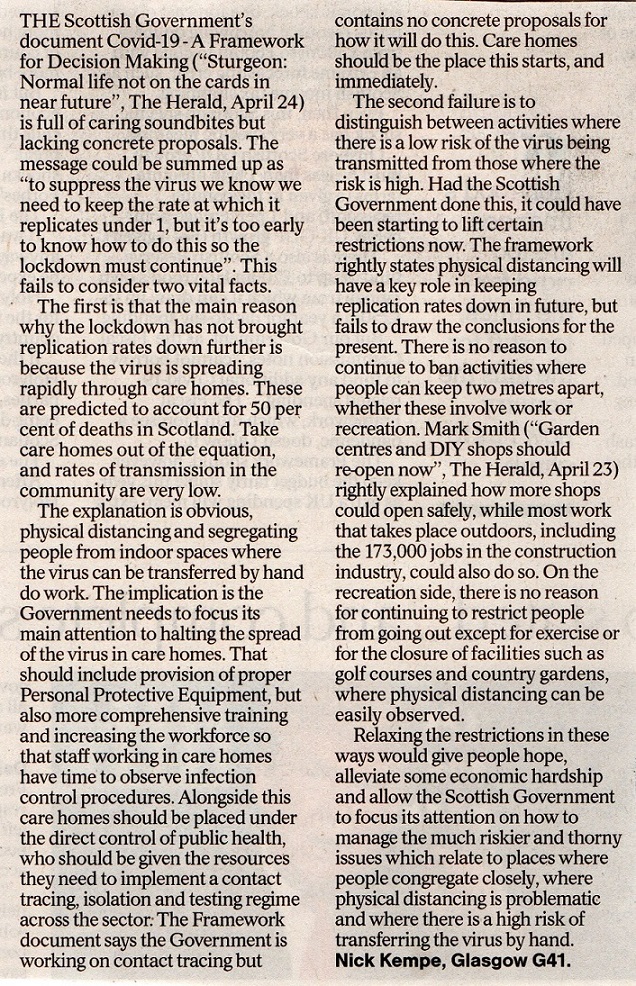
It’s almost impossible to consider rights to go outdoors without looking at the broader context. From the start, apart from those working directly caring for those with Covid-19, it’s been clear that the main groups of people at risk of dying from Covid-19 are Older People and those with serious underlying health conditions. Moreover, where old age is combined with serious underlying health conditions people are particularly at risk. A large proportion of that population lives in Care Homes. It’s hard to think of a higher risk environment for COVID-19 transmission (lots of people needing personal care crammed together looked after by too few staff). Unfortunately our governments completely failed to put in place on time measures that might have helped “shield” them (hence the letter above).
I will avoid the temptation of using parkswatch to say any more about an area where I used to work professionally. The point is that after abandoning the herd immunity policy, both the UK and Scottish Governments have been treating Older People as a homogeneous group distinct from the rest of the population. This has taken very little account of Older People living in very different circumstances and having very different needs.
Before the imposition of the lockdown, both the UK and Scottish Governments issued stronger advice to Older People than the rest of the population about staying at home (see here). At that stage, the Scottish Government distanced itself from the UK Government’s suggestion that Older People might need to be forcibly isolated for four months (see here). The messages coming from two governments now, however, appear far more closely aligned with both Nicola Sturgeon and Matt Hancock last week talking about longer term measures being needed to “protect” Older People.
Current Law and Guidance in Scotland
The Health Protection (Coronavirus) (Restrictions) (Scotland) Regulations 2020 subject Older People to the same restrictions on leaving their homes as everyone else. While the over 70s are eligible for some special help (see here), there is nothing to prevent a 90 year old, for example, from going to the shops if they so wish, even though they might be eligible for a home delivery. This also means that while Older People, like the rest of it, can go out for physical exercise they are equally affected by the attempt to ban activities like sitting in the sun.
The current Scottish Government website does not include any separate guidance for the over-70s. NHS Inform (see here), however, includes the over 70s as the first of a long list of higher risk groups:
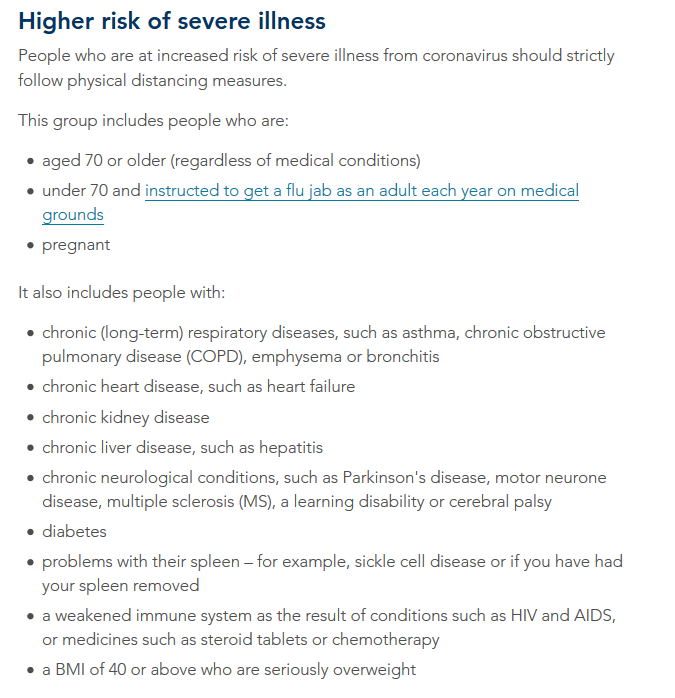
There is, I found to my surprise, no real difference in the advice pertaining to these higher risk groups, apart from the word “STRICTLY” being inserted before “observe Physical Distancing”. The ONLY substantive difference between the advice for the over-70s and that for the under-70s without underlying health problems is that the over-70s can allow friends and family into their homes for “essential care”:
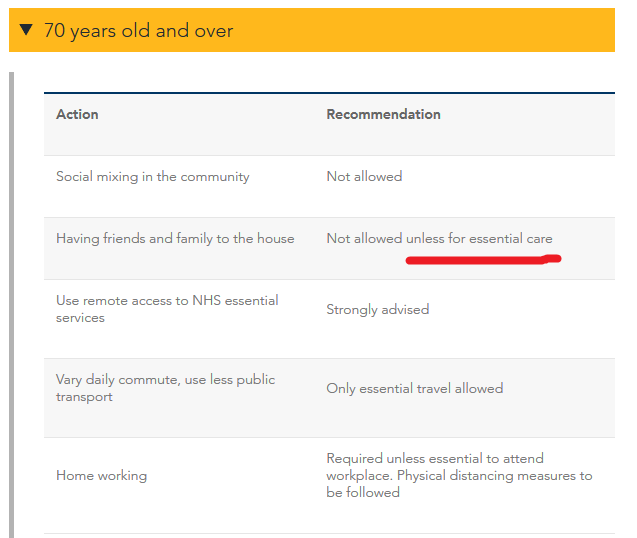
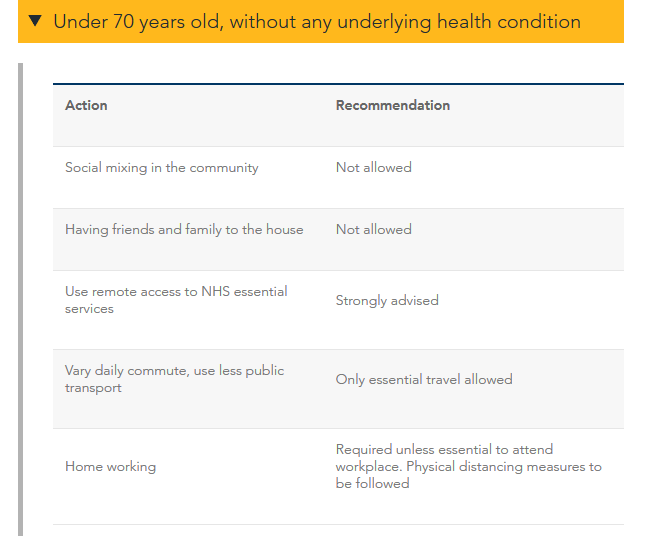
“Essential care” is of course very restrictive and not the same as having a member of your family in for “support”.
Where the advice is different is for people judged to be at extremely high risk where there is reference to shielding measures:
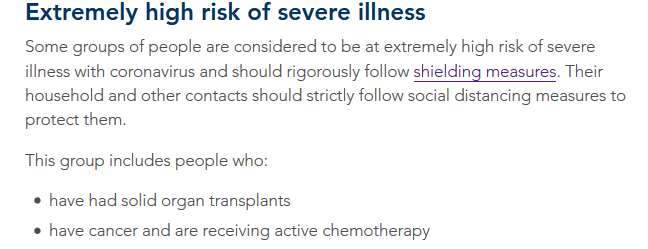
Readers may note that Nicola Sturgeon last week (top quote) referred to shielding as maybe being necessary for foreseeable future for ALL older people and people with health vulnerabilities, not just those at extremely high risk.
Ironically, the guidance on Shielding (see here) is the ONLY advice from the Scottish Government that I have discovered so far that acknowledges people’s right to make choices might be important:
“Shielding is for your personal protection. It’s your choice to decide whether to follow these measures.
The needs of Older People to go outdoors
While the current law and guidance in Scotland thus doesn’t restrict Older People as much as is commonly believed, it also pays no attention to their needs. My peer group are at an age where the surviving members from the previous generation are relatively old, mostly 85 plus. I have heard a great deal in the last few weeks about how they have been responding to the risk of Covid-19 and the lockdown. Here are some of their stories (from Scotland and the wider UK):
- A woman in her eighties who lives alone who has taken up cycling again after a gap of more than 20 years- she feels this is the safest way to get out her house and take exercise
- A 90 year old woman who lives alone and goes for a walk to a local greenspace each day. She has been challenged by police officers for sitting on a park bench and told if she can’t take take exercise without sitting down she shouldn’t be out.
- Two women who live alone, neighbours, who go for a walk with each other each day and who have separately taken their cars to walk together in the countryside. One neighbour used to spend most of her time indoors but now she cannot see people there, she goes out for a walk. I am told her mood has improved considerably.
- A man over 90 who lives alone in sheltered housing and has been driving out of the town where he lives to walk up a small hill each day
- A couple in their eighties who go walking out of their village each day. For the first couple of weeks of the lockdown they took a picnic with them but stopped doing this because they were worried about being confronted.
- And the youngest example, a woman living in a flat without a garden whose family had planned a party for her 80th birthday. It had to be cancelled but a group of friends, all in their 80s, gathered in the street outside to toast her health. I am told each brought a glass and a tea towel, which they each used to pour out a toast – briefly breaking the 2m rule.
A number of these Older People who have gardens have been quietly meeting friends or family there and I also know of some who go out for a walk more than once a day. The first is against the law, the second contrary to both the UK and Scottish government’s guidance which states people should only go out once a day for physical exercise.
Now, this is not a representative sample of Older People. They have lived significantly longer than average and none has any significant cognitive impairment such as dementia. Their views and actions may also have been influenced from having experienced the war as children. They are perhaps less feart as a consequence. I think too the attitude of several to risk is influenced by knowing that, however long they have to live, spending the rest of their lives isolated is a difficult thing to contemplate (and even more difficult now our governments are talking about restrictions lasting for months and more). Better to try and make what you can of life.
None of these Older People are I believe being rash – I doubt they would have got to their age had they been – and in all cases they have made significant changes to their lives, restricting the amount of contact they have with other people. Most of them, however, are breaching the generic government guidance that applies to the population as a whole and some of them the law.
I believe there are very good reasons for their decisions and actions which both the Scottish and UK governments need to acknowledge. Of central importance are:
- Physical health . For most very old people taking exercise once a day is NOT the way physical health and fitness is maintained. Most take exercise in doses, a walk to the shops, a walk to see a neighbour or, if they are taking a longer walk, they take a break. Confining them to their homes makes this very difficult. Stop the walking and very old people lose muscle very quickly and with that the risk of falls etc increases dramatically. It’s particularly important that Older People who don’t have gardens should not feel discouraged from going out to walk more than once a day.
- Mental well-being. Few of the over-80s live their lives through social media and seeing other people and/or contact with nature is thus essential. In the examples above, people have both been driving into the countryside and also arranging to see people in person in their own gardens. They are, however, the outgoing and sociable. The converse to this is that levels of depression among older people living alone is very high – much of this stems from loneliness. The last thing Older People need is MORE social isolation.
The central message here is I believe the same for the very old as for the rest of the population. It’s PHYSICAL distancing that matters (and thank goodness the Scottish Government has started using this term). As long as they can maintain their physical distance and maintain good hygiene, it’s no more irrational or dangerous for the very old to go out than for other age groups.
What needs to happen
The specific needs of Older People, however, could usefully be used to inform changes in the Restriction Regulations going forward and future guidance:
- First, we all need to get out for our mental well-being but Older People are particularly vulnerable if isolated at home. It may not be safe to run indoor clubs and activities but the one thing government could do is to encourage Older People to meet in the outdoors, whether this is their gardens, for those that have them, or in other open spaces.
- Second, Older People are particularly affected by the government guidance which says we can only take exercise once a day. People need to be allowed out little and often
- Third, the guidance in Scotland (but not England) advising people not to drive to is having a severe impact on a small group of Older People who drive to go for a walk and have nowhere to go locally. Being able to drive to a space where you feel safe – say because there are lots of benches available for you to take a rest in a park – is really important. Linked to that, however, is also the need to think about WHAT management measures might make it safer for Older People to go out. Yesterday there was newspaper coverage of a business spraying park benches – all our public authorities should be considering actions like that.
Unfortunately, while the Scottish Government is rightly trying to suppress the corona virus, in its draft framework for decision making (see here) it has not taken account of the adverse consequences of the Stay at Home message or of the right of people to make choices about their own lives :
“Every individual member of Scottish society matters and our entire strategy is focused on preventing every avoidable death. There is no such thing as a level of “acceptable loss”. That is an approach which reflects our commitment to safeguarding human rights and upholding human dignity”.
“Our objective is to contain and suppress the virus in order to minimise the harm it can do.”
Safeguarding of human rights seems to be being considered solely in terms of protecting people from the health risks posed by the corona virus. There are no balancing objectives or attempts to consider the adverse consequences of some of the measures put in place. The most obvious for Older People (for the young its unemployment and poverty) is that because of the Stay at Home message many older people have not been seeking medical treatment they need for other health conditions and some are now dying because of that.
If the Scottish Government started consulting people I believe it would hear plenty of stories like the ones I have recounted here. It might then better appreciate the need to respect the rights of older people to go outdoors and to take decisions about how to do so in a way that is best for them. Instead, in the muddle and the panic the government risks stripping Older People of both their rights and their dignity. As proof of that I cite the case of the police accosting the 90 year old for daring to go for a walk and sit on a park bench.
Have a look at this, and think what might have been or indeed what still has time to be, should there ever be a shred of adult leadership involved: https://www.covid19outdoors.nz/
New Zealand has been held up as something of a paragon in this, and it’s well worth passing on to anyone you know that has any influence at all. A workable template.
I am an ‘Older Person’ and a member of a Golf Club. Physical distancing on the course would not be a problem, and play could be done safely. I received the following guidelines from my Club on 20th March ’20. “When playing, please follow the guidance below, in order to minimise risks of contamination:
On the Golf Course:-
Please wash your hands before and after round.
Do not share golf cards, pens, pencils, tee pegs.
Bunker rakes have been removed from the golf course. We would ask where possible, make an attempt to smooth out any footprints as you leave the hazard with your foot or club.
Always leave the flag pin in the hole and do not touch it.
All hole cups have been turned upside down to reduce the need to remove the flag pin whilst retrieving the golf ball.
Any golf balls rebounding off the pin are deemed to have entered the hole cup.
All ball-washers and waste bin lids have been removed from the golf course.
On completion of your round:-
No handshakes.
The shoe/trolley cleaning air-hoses will not be available for use
In making these changes we are actively following the Governments advice on social distancing and discouraging large social gatherings, the golf courses currently remains open for individuals to play.
These measures will be maintained and in place until further notice.” Of course I would have to drive there and back and even though it is a nine hole course it takes more than an hour to complete (two recommendations to overcome ). I know that other Golf Clubs have issued the same/similar guidelines. This is a form of outdoor recreation enjoyed by many ‘Older People’ who often only play with the same people each game. Face masks could be worn and physical distancing maintained at all times easily. Fresh air and friendship enjoyed!
Drop-down lists that can be used to suggest where outdoor activities may resume in New Zealand are a step in the right direction.
Allowing this lock down to become established without any real assessment about where differing standards might be more appropriate, was a mistake. For an urban setting the risk factors are totally different. For one definition of remoteness I can refer slightly obliquely to the attitude of office staff in the main NHS Highland Hospitals towards the issue of medical appointments. (Those from remoter highland communities will recognise this.) Raigmore outpatient appointments are highly sought after, booked up weeks ahead. The north highlands has only one critical care facility for most medical conditions. Those who live far away may be awarded a daytime outpatient appointments at a time of day that can require an overnight stay in Inverness. If a request is submitted for an alternative slot nearer midday, further delay is inevitable. However, it is no secret, appointment scheduling need take no account of a patient’s physical location. Any difficulty in making a 3 hour journey early enough ( starting before public transport commences ) is apparently “a patients own fault” for living so remotely.
Now it may be understood why this differential treatment standard “cuts both ways”.
Through the Covid alert those people who have elected to live in an urban setting need a different standard of special protection. They live always surrounded by thousands of others . All along they have enjoyed benefits unknown to those who live remotely- Access to entertainment, access to shops 24/7 access to good transport links..access to medical care and access to Police, Fire services and ambulances all on call 8-10 minutes away. Now it appears those who live remotely at last have a small Covid advantage…sheer distance and space. But the urban population cannot be expected to accept being be locked down under rules that apply only to them. They will not tolerate being under extended restrictions which might become relaxed for those who live far, far away.
So now that the physical location tables are turned..and remoteness can be seen as a good safe thing..the needs of conurbations are still being permitted to determine blanket government policy. A period when those who all along chose to accept the many disadvantages of living remotely are now are hardly facing any proportionate risk at all is here, and needs to be addressed ?
You can just walk into the doctors in the central belt and they are sitting waiting on you with a cup of tea and some crackers. Open the countryside there is space for everyone car parks will be busy but everyone does not turn up at the same time as some would like us to believe and remember everyone stay safe don’t watch the bbc hysterical fear propoganda